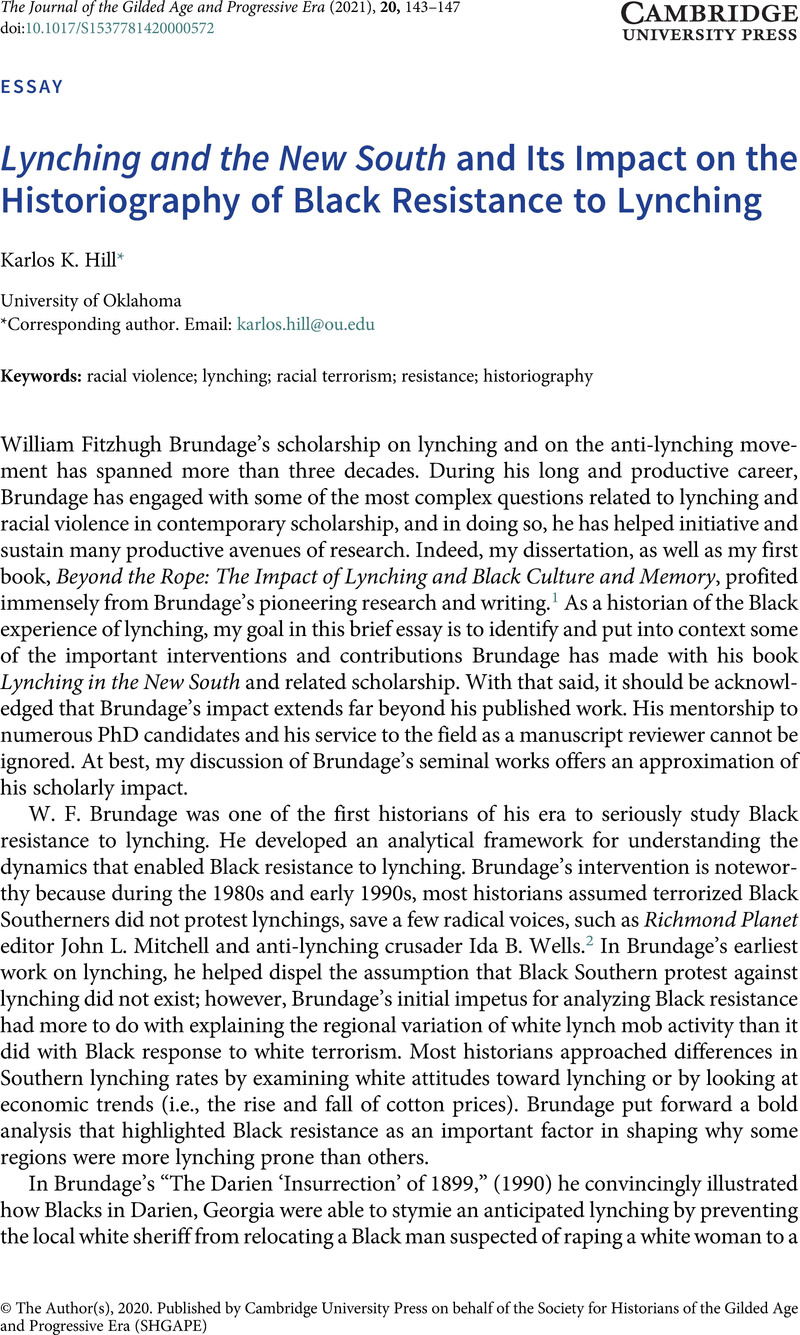No CrossRef data available.
Article contents
Lynching and the New South and Its Impact on the Historiography of Black Resistance to Lynching
Published online by Cambridge University Press: 01 December 2020
Abstract

- Type
- Special Forum: Lynching in the New South A Quarter of a Century Later
- Information
- The Journal of the Gilded Age and Progressive Era , Volume 20 , Issue 1 , January 2021 , pp. 143 - 147
- Copyright
- © The Author(s), 2020. Published by Cambridge University Press on behalf of the Society for Historians of the Gilded Age and Progressive Era (SHGAPE)
References
Notes
1 Hill, Karlos K., Beyond the Rope: The Impact of Lynching on Black Culture and Memory (New York: Cambridge University Press, 2016).CrossRefGoogle Scholar
2 Brundage, W. Fitzhugh, “The Darien ‘Insurrection’ of 1899: Black Protest During the Nadir of Race,” Georgia Historical Quarterly 78 (1994): 257–80.Google Scholar
3 Representative scholars include Ingalls, Robert P., “Lynching and Establishment Violence in Tampa, 1858–1935,” Journal of Southern History 53 (1987): 626; John D. Wright Jr., “Lexington’s Suppression of the 1920 Will Lockett Lynch Mob,” Register of the Kentucky Historical Society 84 (1986): 263–79; Walter T. Howard, “Vigilante Justice and National Reaction: The 1937 Tallahassee Double Lynching,” Florida Historical Quarterly 67 (1988): 64–81; Jack E. Davis, “‘Whitewash’ in Florida: The Lynching of Jesse Payne and Its Aftermath,” Florida Historical Quarterly 68 (1990): 277–98; Eric W. Rise, “Race, Rape, Radicalism: The Case of the Martinsville Seven, 1949–1951,” Journal of Southern History 58 (1992): 461–90; Stephen J. Leonard, Lynching in Colorado, 1858–1919 (Boulder: University of Colorado Press, 1995).Google Scholar
4 Brundage, W. Fitzhugh, Lynching in the New South, Georgia and Virginia, 1880–1930 (Urbana: University of Illinois Press, 1993).Google Scholar
5 Cha-Jua, Sundiata, “‘A Warlike Demonstration’: Legalism, Violent Self-Help, and Electoral Politics in Decatur, Illinois, 1894–1898,” Journal of Urban History 26 (2000): 591–629.CrossRefGoogle Scholar
6 Brundage, W. Fitzhugh, “The Roar on the Other Side of Violence” in Under the Sentence of Death: Lynching in the South, ed. Brundage, W. Fitzhugh (Chapel Hill: University of North Carolina Press, 1997), 271–91.Google Scholar
7 Hill, Karlos, “Resisting Lynching: Black Grassroots Responses to Lynching in the Mississippi and Arkansas Deltas, 1880–1938,” (PhD diss., University of Illinois, Urbana, Illinois, 2009).Google Scholar
8 Representative works include Christopher Waldrep, African Americans Confront Lynching: Strategies of Resistance from the Civil War to the Civil Rights Era (New York: Rowman and Littlefield, 2009); Leigh Raiford, Imprisoned in a Luminous Glare: Photography and the African American Freedom Struggle (Chapel Hill: University of North Carolina Press, 2011); Kidada E. Williams, They Left Great Marks on Me: African American Testimonies of Racial Violence from Emancipation to World War I (New York: New York University Press, 2012); Koritha Mitchell, Living with Lynching: African American Lynching Plays, Performance, and Citizenship, 1890–1930 (Urbana: University of Illinois Press, 2012); and Sandy Alexandre, The Properties of Violence: Claims to Ownership in Representations of Lynching (Oxford: University Press of Mississippi, 2012).Google Scholar
9 Williams, They Left Great Marks on Me.


